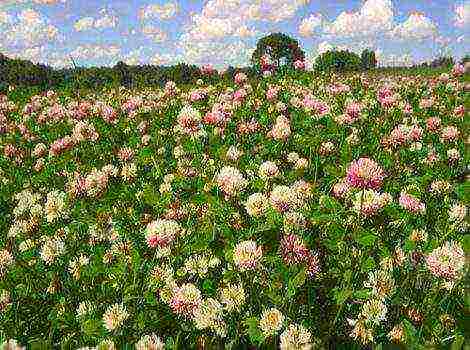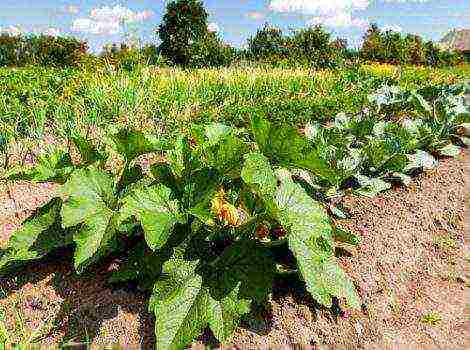Content
- 1 General description of the plant
- 2 The most common varieties
- 3 Optimal sowing time
- 4 Growing daisies
- 5 Follow-up care
- 6 Disease and pest control
- 7 Decorative ways to use daisies
- 8 General description of the plant
- 9 The most common varieties
- 10 Optimal sowing time
- 11 Growing daisies
- 12 Follow-up care
- 13 Disease and pest control
- 14 Decorative ways to use daisies
- 15 Planting daisies outdoors
- 16 Growing daisies from seeds When to plant seedlings
- 17 Daisy propagation by cuttings
- 18 Reproduction of daisies by dividing the bush
- 19 Sowing daisy seeds in open ground
- 20 Planting daisy seedlings in open ground
- 21 Outdoor Daisy Care
- 22 Diseases and pests of daisies
- 23 How to collect daisy seeds
- 24 Preparing daisies for winter
- 25 Daisies in landscape design What to combine with
- 26 Types and varieties of perennial daisies with descriptions and photos
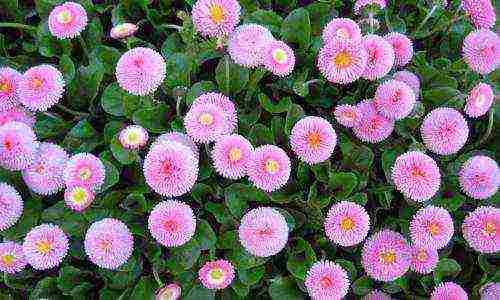
Daisy is a beautiful double flower that pleases with lush flowering for a long time. It can become a real decoration of your site.
Large, double, undersized, with different colors - any variety of flowers has its own unique look and beauty. Flowers can be grown not only on the personal plot, but also at home.
Daisies are propagated by seeds or by dividing bushes. Flowers grown from seeds are popular because they can be used to implement any ideas.
Growing from seeds at home begins 2 months before flowering, usually March-April. Germination temperature should be at least 21 ° C. After 2 weeks, the first shoots appear. After the appearance of the leaves, the seedlings need to dive, and after a while they should be planted in a permanent place.
For daisy flowers, cultivation must be carried out in compliance with certain rules.
They are not planted deeply, but sprinkled lightly with soil or river sand. They are planted in loose, well-fertilized, moist soil. The soil should not be wet or muddy. The soil must contain clay or sand. Better to plant them where there is good lighting.
At the time of planting, you need to use compost and humus. A good option is to add ammonium nitrate and potassium chloride during the growth process, with the help of which the flower will grow much faster.
In the second year, the flowers begin to bloom in May, continuing to delight with lush flowering all summer. Bloom again in September. The height of the plant is about 20 cm. In the first season, a leaf rosette grows, and next year the flower will bloom profusely. He tolerates the transplant well.
The first feeding is done immediately after the soil thaws. In early June, it is good to feed the flowers with an easily soluble fertilizer - nitroammophos. It is desirable that the fertilizer used contains phosphorus, which will improve the growth of the plant in the first season.
You can feed with a solution of agriculture and nitrophoska. These preparations are diluted in 10 liters of water, and then at least 1 liter is poured under each plant.
Water the daisies in moderation but regularly. On hot days, watering needs to be increased, but usually it is carried out about 3-4 times a week. From a lack of moisture, the flowers can become smaller and turn yellow.
Conveniently, daisies require almost no protection from disease. If the plant has damage, then it is simply removed along with the earth. In rare cases, powdery mildew, caterpillars or slugs may appear.
You can treat the flowers with a Topaz solution or other similar remedy. It is necessary to remove wilted inflorescences in time so that the plant does not consume nutrients on dead areas.
For reproduction, you can divide the flower bushes at the end of summer and plant them separately. This is a faster process than planting with seeds. The distance between the bushes should be about 20 cm. You can do this even during flowering. The plant is constantly renewing itself and gives young shoots.
Mulching the soil with sawdust, humus, peat will help preserve flowers better in winter. In autumn, it is advisable to cover the daisy with spruce branches, straw or leaves.
The plant goes well with many flowers. It can be used as a carpet plant or used to frame a pond with tulips, forget-me-nots or ferns. Daisies are well suited for decorating flower beds, borders, lawns.
Unpretentiousness, beauty and long flowering - these qualities of daisies are appreciated by many growers. Well-groomed plants will delight you with brightness, beauty and create a special festive mood.
Daisies - beautiful flowering plants that not only decorate the garden, but can also be grown at home. There are a huge number of varieties. There are no particular differences between cultivation in the open field and at home.
Planting daisies
These plants reproduce in several ways. One of them is the division of the bushes. For this, plants are used that are two years old or more. When seated, daisies rejuvenate, again begin to actively grow and bloom. The division is carried out in the summer, around July. Usually plants at this time suspend flowering somewhat. The bushes are taken out of containers and divided into smaller ones.
At the separated bushes, the leaves and buds are cut, the roots are cut. After that, they are planted in prepared soil. Containers with newly planted plants are placed in partial shade and watered more often. Some growers recommend dividing not in summer, but in autumn or spring.
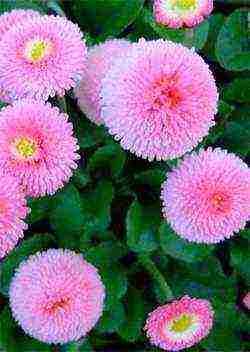 The second way of reproduction is by cuttings. Plants are cut in May or early summer. To do this, cut off the side shoots, which are then planted in soft soil. It should be very loose. After about two weeks, the cuttings take root. Such daisies bloom only after a year.
The second way of reproduction is by cuttings. Plants are cut in May or early summer. To do this, cut off the side shoots, which are then planted in soft soil. It should be very loose. After about two weeks, the cuttings take root. Such daisies bloom only after a year.
A very simple and convenient way of reproduction is seed propagation. Seeds of a wide variety of daisies are sold in all specialty stores. Seeds are sown on the surface of the soil and lightly sprinkled with sand or loose substrate. Daisies sprout in about a week or ten days.
After the daisies grow up, they are planted in a permanent place. At the same time, the roots are slightly pruned so that the root system begins to branch. As a result, the plants will be stronger and stronger.
Seed-grown daisies bloom, depending on when they are planted. Seeds sown in early spring will produce flowering plants this season, and sown in summer will produce daisies that will bloom next summer.
Growing daisies
Daisies love bright sunlight, so well-lit places are good for them. The best option would be partial shade or diffused light, since in such conditions the flowers will be more lush. You should not place daisies in the shade, as they stop growing, practically do not bloom and feel uncomfortable.
The soil needs to be well drained and retain moisture. A good option is loamy soil, into which additional humus is introduced. The container for growing daisies at home should be wide and shallow.
Watering regular and plentiful is required. With a lack of moisture, the plants remain small, their flowers become smaller and lose their fluffiness.
Top dressing daisies are required periodically. For plants that grow in open ground, two dressings per season are enough. At home, the volume of soil is limited, so feeding should be done at the same frequency as for other flowering indoor plants, namely once every two or three weeks. The fertilizer is used as a complex. You can alternate between mineral and organic compounds. Top dressing is especially important in early spring, since it is at this time that the plant starts growing.
Daisies growing in a house or apartment endure the cold period without any special conditions. Their growth slows down and they are waiting for spring to resume active growth and flowering. After two years, daisy bushes begin to age and need to be planted for rejuvenation.
The daisy is a perennial ornamental plant, distinguished by double inflorescences and elongated green leaves. You can find him in red, white or pink color. The peculiarity of the daisy is that it can reproduce both by cutting bushes and by cuttings or seeds. Bright appearance and unpretentiousness made this plant a real treasure for landscape designers and gardeners. More details about daisies - growing from seeds will be discussed in this article.
Daisies - growing from seed
General description of the plant
Most often, this plant can be found in the Mediterranean countries and western Europe. There are more than 15 types of daisies, but only 2 of them are used by gardeners: perennials and annuals. The former are used for growing in gardens, the latter in pots. Many have heard about the incredible meteorological abilities of daisies - the flowers of the plant, when closed, nestle on the ground, before the rain.
Daisies
The height of the plant is no more than 20 cm, it looks a little like a small bush in its appearance. The daisy has a bare, leafless stem, although in its lower part, at the very base, long blunt-pointed leaves grow. The root system is branched, but small. The plant is distinguished by a large number of inflorescences that resemble baskets in their unusual shape. Inflorescences are ligulate and tubular.
Perennial pink daisies
On a note! It is advisable to grow daisies as a biennial plant. This will allow gardeners to enjoy the shape and size of the inflorescences for a long time. Flowering occurs at the end of April - first half of May.
Daisy flowers - description
The most common varieties
Cute daisies can decorate any corner of your home or garden. Despite its simplicity, the cute beauty of these plants will always attract people's eyes. If you decide to grow daisies at home, then first you will need to decide on the variety, because there are many of them. Below are the most common varieties of this plant that are grown in Russia.
Table. Popular varieties of daisies.
|
Belladaisy |
An early plant, characterized by bright red or pink inflorescences, the diameter of each of them is 2.4 cm. From the moment of sowing the seeds to the first flowering, 110-125 days pass. The stems are small, about 10 cm high. |
|
Bellissima |
Another daisy variety that has large flowers up to 5 cm in diameter, painted in white, red or pink. Already in the first year of plant growth, flowering begins. The stems can grow up to 12 cm. |
|
Rominetto |
Small two-centimeter flowers are the hallmark of this daisy variety. Inflorescences are red, pink or carmine. Despite the small size of the flowers, the plant can reach 15 cm in height. |
|
Robella |
A very beautiful plant with bright pink-salmon inflorescences.The flowers grow up to 4-5 cm in diameter, and the stem is up to 18 cm in height. Because of the decorative qualities, gardeners often prefer to grow this particular variety. |
|
Tasso |
The unusual shape of the petals in combination with the lush terry inflorescences made the plant very popular. This is not strange, because the well-known organization "Floroselect" gave this variety a prize because of its good decorative qualities. The plant grows up to 15 cm in height. |
|
Speedstar |
Flowering of this variety begins in the first year after sowing. The daisy grows up to 14 cm. |
|
Habanera |
Another popular daisy variety, characterized by large double inflorescences up to 8 cm in diameter. Pink or red inflorescences combined with rare petals decorated with a light openwork pattern create an incredible picture. The stem height can be up to 16 cm. |
Optimal sowing time
It is advisable to sow daisies in the second half of June - early July, that is, in the middle of summer. But if you plan to plant ready-made seedlings in open ground, then it is recommended to do this in the fall. In this case, you do not need to burrow the seeds too much into the soil - just press them lightly with your finger and roll them a little.
Growing daisies
This is a simple process that even people who are not strong in gardening can do. Therefore, if you want to start your "creative" life by growing a flower, perhaps start with daisies. Often people grow this plant from seed, but more experienced gardeners use a different method - dividing the bush.
Reproduction of daisies by division
If in the first case everything is banal and simple, then in the second you will have to work a little. Of course, before sowing, you need to take care of the seeds and soil.
Blooming daisies
Soil and seed preparation
Any well-drained and cultivated soil is suitable for growing daisies. Loams are often used because of their qualities (they retain moisture well). When preparing a bed for daisies, it is advisable to fertilize the soil with rotted manure in the fall. This should be enough for the plant for almost a whole year.
Despite the plant's light-loving nature, it also feels good in conditions of slight shading. Of course, when growing in partial shade, they will not bloom so luxuriantly, although the leaves will become more tender, and the flower stalks will be tall. When grown on the sunny side, the growth of daisies will be more vigorous and abundant, but the plant height will be correspondingly lower. The best place to grow is an area that is not exposed to midday sun rays.
Soil for growing daisies
To grow daisies, you can use not only purchased seeds, but also collected with your own hands - in both cases they will grow well. But if you decide to collect the seed yourself, in no case use hybrid plants for collection. Otherwise, plants may lose their varietal characteristics over time. We are talking about the diameter of the inflorescences, the color of the leaves, flowers, and so on. No seed preparation is required before planting daisies - this is how easy they are to grow.
Daisy seeds
Planting seeds
Having decided on the variety, you can start growing. Often sowing seed directly into the beds is also correct. But we will consider a method of planting seeds in containers.
Table. Planting daisy seeds.
|
Step one |
After choosing a suitable container for growing (in this case, it is a tray), fill it with potting soil. Often people do not bother preparing it, so they buy soil in specialized stores. After that, shake the soil a little so that it is distributed over the entire container. |
|
Step two |
Use a ruler to make special grooves for the seeds in the soil. The distance between them is 1.5-2 cm. |
|
Step three |
Open the seeds and start sowing them.Daisy seeds are small, so sow them as if you were adding salt to a dish. At the same time, try not to cover the seeds with soil. |
|
Step four |
Moisten the ground with a spray bottle. The soil should be moderately moist. It is not recommended to water it with a watering can or glass, as this can wash the daisy seeds out of the grooves. |
|
Step five |
Place a plastic lid on the container, and be sure to write the name of the daisy variety on it with a marker and the planting date. Do not place the container on the window. The optimum temperature for germinating daisies is + 25-28 ° C. |
|
Step six |
After the first shoots appear, remove the lid from the container. You can also lower the temperature slightly, down to about + 18 ° C. |
Daisy shoots
Follow-up care
As noted earlier, daisies are considered unpretentious plants that can survive not only drought, but also other, more unfavorable conditions. In the spring, you need to feed the daisies with special store fertilizers for flowers. When blooming, try to regularly pinch off the baskets that are starting to fade, thus preventing the daisies from tying seeds. Such actions prolong the flowering period, since the plant believes that the attempt to leave offspring was unsuccessful, therefore, it must be repeated.
Daisy seedlings
On a note! If you grow perennial daisies in the garden, then you must definitely divide and transplant the plant (at least once a year). This is a troublesome procedure, but this is the only way to achieve the annual full flowering of daisies without losing their decorative qualities. If we talk about watering, then it should be moderate. The plant can easily survive a drought, but waterlogged soil can become a problem for her. Watering twice a week is enough.
The use of daisies in landscaping.
Disease and pest control
Daisies are quite resistant to various diseases and pests, but still there is a certain likelihood of contracting the virus. In rare cases, the leaves of the plant begin to fade and shrink in size, the inflorescences become smaller, and the stems begin to stretch out. As a rule, this happens in the first half of summer. If you suddenly notice such deviations in development, then the diseased plants should be burned, and they need to be destroyed from the roots. And the place where the affected daisies grew, immediately treat with a solution of potassium permanganate.
Also, the plant can get sick with powdery mildew, which is accompanied by the appearance of a gray bloom on the surface of flowers and leaves. The resulting fungus can be eliminated with Bordeaux mixture or colloidal sulfur. One of these means is to process all the flowers in the garden. And with affected daisies, you already know what to do.
The defeat of daisies with powdery mildew
Sometimes daisies need to be saved from ticks. To do this, treat the plants with Aktellik or Karbofos. If you find mice on your site, from which, by the way, plants can also suffer, then you need to decompose special baits with poison. The troubles that can happen to your daisies exist, but there are very few of them. In addition, in the end, a pleasant surprise awaits you - a reward for the effort and time spent in the form of a beautiful and long flowering.
Decorative ways to use daisies
Most often, for decorative purposes, daisies are used as a small portable garden. To create a stylish and beautiful landscape, you must initially consider all the options for placing plants in pots. Vases, fine stone containers, or wood or ceramic pots can be used. Plastic molds are considered the most economical solution. To decorate your home, daisies are best placed in resting places (on the porch, next to water bodies, in secluded corners, and so on).Thanks to this arrangement, you can achieve the desired calmness and tranquility.
Perennial daisy
Daisies in the flowerbed
Daisies in the garden
This plant is also often used to create decorative plant rugs. To do this, you need to choose large, semi-shaded areas. In such conditions, the daisy will bloom for a long time and brightly, and thanks to a well-chosen place, its leaves will remain until the end of autumn. In terms of choosing a composition, your hands are completely untied, because when creating a carpet from plants, you can choose not only monotonous varieties and types of plants. For example, taller and darker flowers can be planted around the edges, and large and bright Bellissima inflorescences can be planted in the center.
Video - Planting and caring for daisies
Today, daisies are popular with flower growers; they are planted in personal plots, dachas, balconies and loggias. This is due to the fact that caring for flowers is simple, and the flowering is colorful and varied, because many varieties of this culture differ significantly in size, flower shape, level of terry, type of flowering and color. Growing daisies from seeds at home is not difficult.
The best varieties
Daisies are perennial and annual flowers from the Astrov family, with bright green elongated leaves and a large number of inflorescences, depending on the type, they have a different shape and color of flowers.
The plant grows in the form of bushes, the height of which does not exceed 25 cm. The root of daisies is short, and the stem is almost leafless. Wild species differ from garden species in that the size of their inflorescences is several times smaller.
Daisies that are cultivated in floriculture are divided into varieties according to the following characteristics:
- flower size (small-flowered - up to 4 cm, medium-flowered - up to 6 cm, large-flowered - up to 8 cm);
- the shape of the inflorescences (pink, reed, pompom, tubular, spherical);
- type of flower (simple, semi-double, double).
The most popular varieties of daisies are:
- Pompon - have small flowers, but inflorescences can grow up to 40 pieces, bloom from April to June;
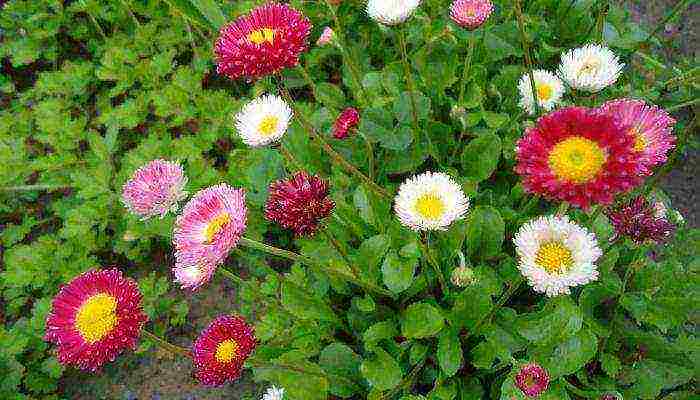
- Schneebel - flowers are large and white, there are many inflorescences, begins to bloom from the end of spring;
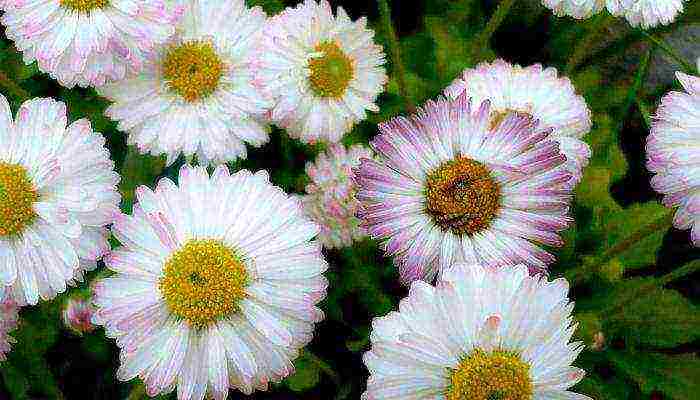
- Monstroza is a terry daisy with pink inflorescences, the diameter of the inflorescences is about 5 cm;
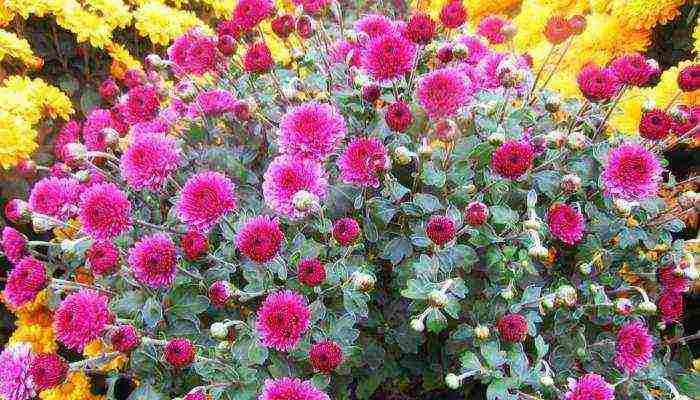
- Snowball - got its name from the shape of the flowers, they are quite fluffy, the inflorescences are large, there are about 25 of them;
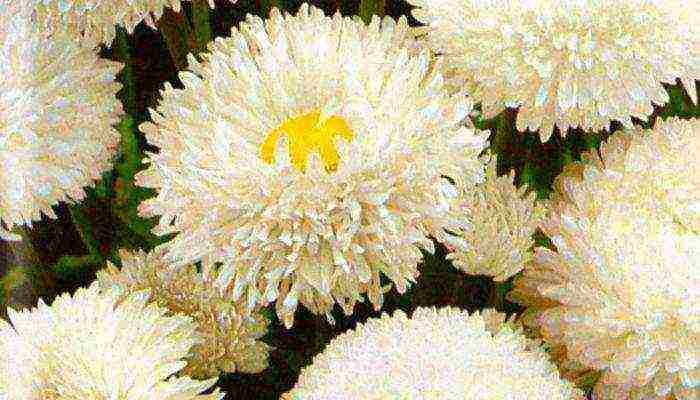
- Red carpet - has terry red inflorescences, ball-shaped baskets up to 6 cm in diameter;
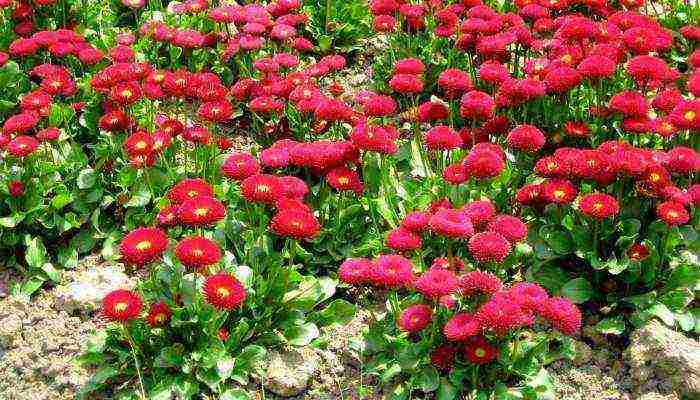
- Etna - flowers of a rich burgundy color, can have about 20 inflorescences;
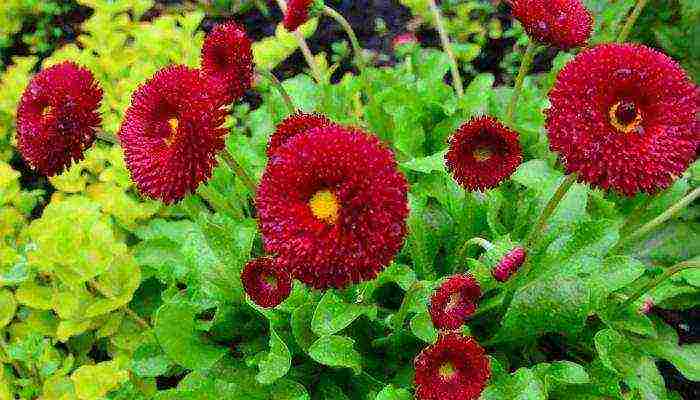
- Tasso - from a series of pompom daisies with large baskets, tubular flowers, there are about 20 of them;
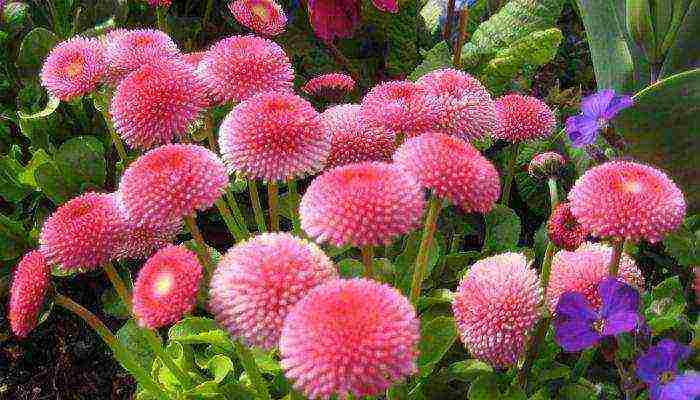
- Rominette - has dense double flowers with a diameter of about 2 cm;
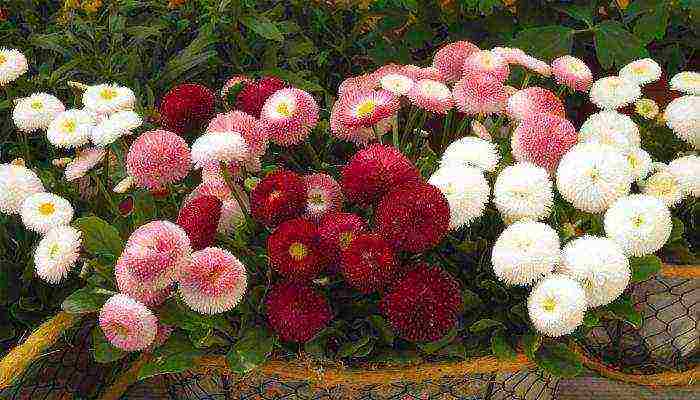
- Cape daisy - has numerous inflorescences of various colors, the diameter of the flowers varies from 4 to 10 cm;
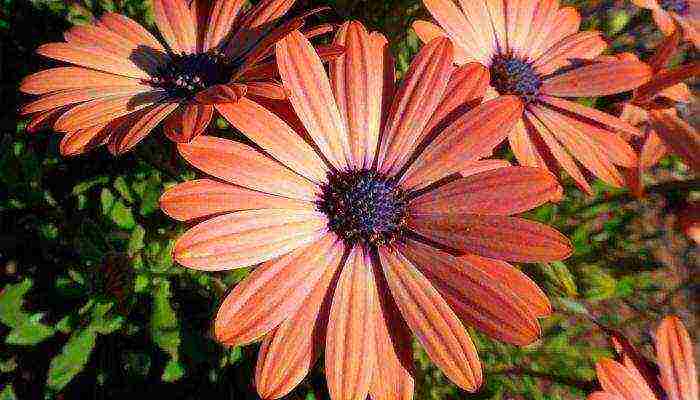
- Rose gigantea - large plant flowers have a pink tint, blooms from May to June;
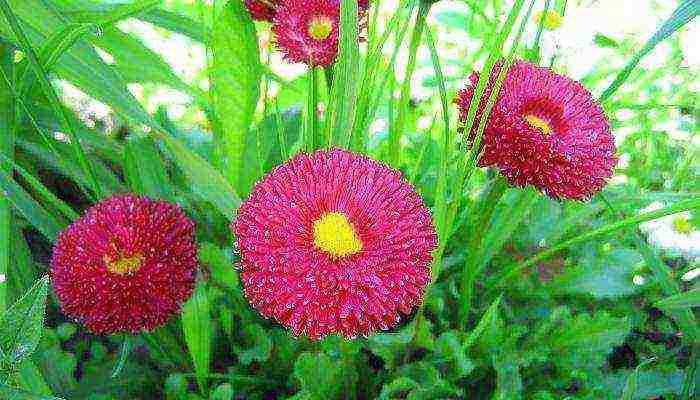
- Spring Dream - winter-hardy daisies with flowers of red, white and pink flowers, flowering lasts from April to July;
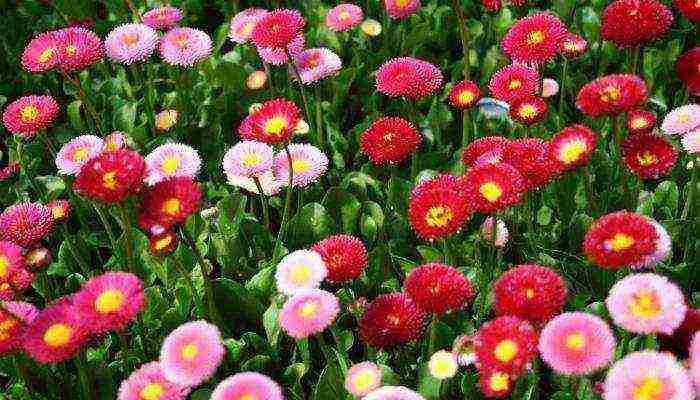
- Red ball - semi-double flowers of the language type have a red color and can reach 6 cm in diameter;
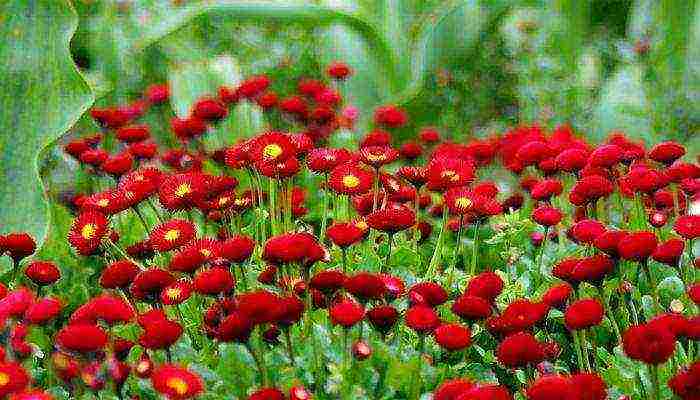
- Confetti - baskets are quite large, up to 8 cm in diameter, red and white.
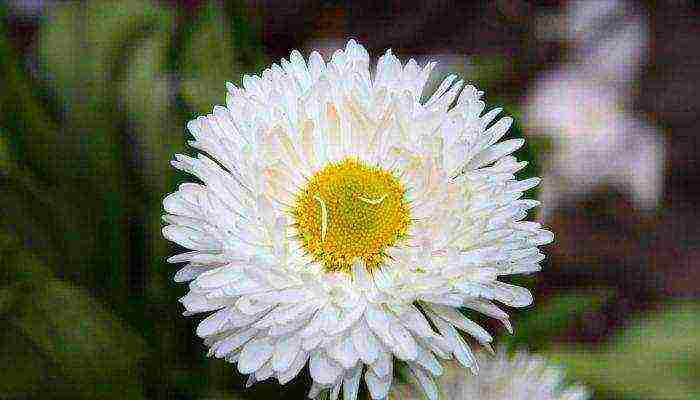
back to contents ↑ Preparation of seeds and soil
Daisies can be grown either with purchased seeds or harvested independently. It is not recommended to plant seeds collected from hybrid varieties, because they do not retain varietal accessories in the future and do not bring the desired result if they are planted again.
Experienced florists recommend irradiating the planting material with red light, the wavelength of which should be approximately 657 nm, and the duration of this procedure is a little more than two hours.After such treatment, the seeds can be planted at any depth and do not worry that they will not sprout.
You can also pelletize the seeds, during which they are covered with a protective shell consisting of nutrients, which, in turn, will protect the seeds from fungal diseases and insects.
Almost any soil is suitable for daisies, except for too acidic and alkaline. The planting soil is heated and treated with herbicides to eliminate weeds. It must be loosened to the depth of sowing the seeds, the substrate must be moist and have high-quality drainage, moisture must be able to linger in the soil, but the root system of flowers must also breathe. It is better to sow seeds in separate containers that will be in the room, because the optimum temperature for seedlings to emerge is 20-21 degrees Celsius.
back to content ↑ When to plant
Daisies delight the eye with magnificent flowering from spring to late summer, but, as a rule, perennial varieties bloom only in the second year after planting, because they have a long period of development. In order for flowers to bloom in the first year, gardeners sow seeds for seedlings and it is recommended to do this at the end of February - at the beginning of March, in this case, by June, you can get ready-made seedlings for planting in a permanent place of growth. Additional lighting is indispensable, daylight hours should be 12 hours.
back to content ↑ Seedling care
Having planted the seeds, the container is covered with a film to create a mini-greenhouse, after two days it must be removed. Drying out of the soil must not be allowed. Under optimal conditions, the first shoots will appear in two weeks. At this time, you need to pick the seedlings. Water the seedlings with water with the addition of mineral fertilizers. When the cotyledons open, the temperature should be reduced to 15 degrees so that the plants do not have time to stretch, daylight hours cannot be reduced, so you will have to highlight it as long as necessary. The soil in containers must be periodically loosened to provide fresh air to the roots.
back to contents ↑ Transfer to open ground
You can plant daisy seedlings in a permanent place already in June in a heated soil. This must be done carefully, together with the lump of soil in which they grew, so that the root system does not damage, the soil must be sufficiently drained. The distance between plantings must be kept within 20 cm. It is recommended to plant seedlings in well-lit areas. In the fall, the site needs to be prepared by introducing rotted manure for digging.
back to contents ↑ Care after
The root system of daisies does not go deep, so watering is necessary often, in dry weather - in the morning and in the evening. Loosen the soil in the area where the flowers grow, preferably regularly to saturate it with oxygen. Mulching the ground will help retain moisture if watering is often impossible. If the inflorescences begin to shrink, then there is not enough moisture.
For the first feeding of seedlings, weakly concentrated fertilizers containing nitrogen and potassium are used. The second feeding is applied at the beginning of flowering, for this they use ammonium nitrate, superphosphate, a mixture of potassium sulfate or mullein infusion. To extend the flowering period on flowers, remove faded baskets.
back to content ↑ Diseases and pests
Daisies are popular among flower growers because they are quite resistant to the effects of various pests and diseases. But sometimes they are affected by diseases such as cercospora, septoria or root rot. You can fight them by spraying with fungicides. Acaricides will help from ticks, from caterpillars and slugs, metaldehyde is laid out on the site in the amount of 30 grams per 1 square meter. If the flowers are affected by powdery mildew, they are removed or sprayed with garlic infusion.In case of infection with daisy rust, the diseased plant is immediately removed, since even the use of chemicals for this disease is not effective.
back to contents ↑ Preparing for winter
Daisies usually survive well under the snow; there is no need to cut off the aerial part of the flower. But, in order to be completely calm for your flower bed, you can cover them with a layer of sawdust, dry foliage or spruce branches. These procedures are needed to ensure the safety of the roots, which can rise from the soil from sudden temperature changes. If, before wintering, a bare root system was noticed, it should be sprinkled with soil.
The daisy is a perennial ornamental plant, distinguished by double inflorescences and elongated green leaves. You can find him in red, white or pink color. The peculiarity of the daisy is that it can reproduce both by cutting bushes and by cuttings or seeds. Bright appearance and unpretentiousness made this plant a real treasure for landscape designers and gardeners. More details about daisies - growing from seeds will be discussed in this article.
Daisies - growing from seed
General description of the plant
Most often, this plant can be found in the Mediterranean countries and western Europe. There are more than 15 types of daisies, but only 2 of them are used by gardeners: perennials and annuals. The former are used for growing in gardens, the latter in pots. Many have heard about the incredible meteorological abilities of daisies - the flowers of the plant, when closed, nestle on the ground, before the rain.
Daisies
The height of the plant is no more than 20 cm, it looks a little like a small bush in its appearance. The daisy has a bare, leafless stem, although in its lower part, at the very base, long blunt-pointed leaves grow. The root system is branched, but small. The plant is distinguished by a large number of inflorescences that resemble baskets in their unusual shape. Inflorescences are ligulate and tubular.
Perennial pink daisies
On a note! It is advisable to grow daisies as a biennial plant. This will allow gardeners to enjoy the shape and size of the inflorescences for a long time. Flowering occurs at the end of April - first half of May.
Daisy flowers - description
The most common varieties
Cute daisies can decorate any corner of your home or garden. Despite its simplicity, the cute beauty of these plants will always attract people's eyes. If you decide to grow daisies at home, then first you will need to decide on the variety, because there are many of them. Below are the most common varieties of this plant that are grown in Russia.
Table. Popular varieties of daisies.
|
Belladaisy |
An early plant, characterized by bright red or pink inflorescences, the diameter of each of them is 2.4 cm. From the moment of sowing the seeds to the first flowering, 110-125 days pass. The stems are small, about 10 cm high. |
|
Bellissima |
Another daisy variety that has large flowers up to 5 cm in diameter, painted in white, red or pink. Already in the first year of plant growth, flowering begins. The stems can grow up to 12 cm. |
|
Rominetto |
Small two-centimeter flowers are the hallmark of this daisy variety. Inflorescences are red, pink or carmine. Despite the small size of the flowers, the plant can reach 15 cm in height. |
|
Robella |
A very beautiful plant with bright pink-salmon inflorescences. The flowers grow up to 4-5 cm in diameter, and the stem is up to 18 cm in height. Because of the decorative qualities, gardeners often prefer to grow this particular variety. |
|
Tasso |
The unusual shape of the petals, combined with the lush terry inflorescences, made the plant very popular.This is not strange, because the well-known organization "Floroselect" gave this variety a prize because of its good decorative qualities. The plant grows up to 15 cm in height. |
|
Speedstar |
Flowering of this variety begins in the first year after sowing. The daisy grows up to 14 cm. |
|
Habanera |
Another popular daisy variety, characterized by large double inflorescences up to 8 cm in diameter. Pink or red inflorescences combined with rare petals decorated with a light openwork pattern create an incredible picture. The stem height can be up to 16 cm. |
Optimal sowing time
It is advisable to sow daisies in the second half of June - early July, that is, in the middle of summer. But if you plan to plant ready-made seedlings in open ground, then it is recommended to do this in the fall. In this case, you do not need to burrow the seeds too much into the soil - just press them lightly with your finger and roll them a little.
Growing daisies
This is a simple process that even people who are not strong in gardening can do. Therefore, if you want to start your "creative" life by growing a flower, perhaps start with daisies. Often people grow this plant from seed, but more experienced gardeners use a different method - dividing the bush.
Reproduction of daisies by division
If in the first case everything is banal and simple, then in the second you will have to work a little. Of course, before sowing, you need to take care of the seeds and soil.
Blooming daisies
Soil and seed preparation
Any well-drained and cultivated soil is suitable for growing daisies. Loams are often used because of their qualities (they retain moisture well). When preparing a bed for daisies, it is advisable to fertilize the soil with rotted manure in the fall. This should be enough for the plant for almost a whole year.
Despite the plant's light-loving nature, it also feels good in conditions of slight shading. Of course, when growing in partial shade, they will not bloom so luxuriantly, although the leaves will become more tender, and the flower stalks will be tall. When grown on the sunny side, the growth of daisies will be more vigorous and abundant, but the plant height will be correspondingly lower. The best place to grow is an area that is not exposed to the midday sun.
Soil for growing daisies
To grow daisies, you can use not only purchased seeds, but also collected with your own hands - in both cases they will grow well. But if you decide to collect the seed yourself, in no case use hybrid plants for collection. Otherwise, plants may lose their varietal characteristics over time. We are talking about the diameter of the inflorescences, the color of the leaves, flowers, and so on. No seed preparation is required before planting daisies - this is how easy they are to grow.
Daisy seeds
Planting seeds
Having decided on the variety, you can start growing. Often sowing seed directly into the beds is also correct. But we will consider a method of planting seeds in containers.
Table. Planting daisy seeds.
|
Step one |
After choosing a suitable container for growing (in this case, it is a tray), fill it with potting soil. Often people do not bother preparing it, so they buy soil in specialized stores. After that, shake the soil a little so that it is distributed over the entire container. |
|
Step two |
Use a ruler to make special grooves for the seeds in the soil. The distance between them is 1.5-2 cm. |
|
Step three |
Open the seeds and start sowing them. Daisy seeds are small, so sow them as if you were adding salt to a dish. At the same time, try not to cover the seeds with soil. |
|
Step four |
Moisten the ground with a spray bottle. The soil should be moderately moist.It is not recommended to water it with a watering can or glass, as this can wash the daisy seeds out of the grooves. |
|
Step five |
Place a plastic lid on the container, and be sure to write the name of the daisy variety on it with a marker and the planting date. Do not place the container on the window. The optimum temperature for germinating daisies is + 25-28 ° C. |
|
Step six |
After the first shoots appear, remove the lid from the container. You can also lower the temperature a little, to about + 18 ° C. |
Daisy shoots
Follow-up care
As noted earlier, daisies are considered unpretentious plants that can survive not only drought, but also other, more unfavorable conditions. In the spring, you need to feed the daisies with special store fertilizers for flowers. When flowering, try to regularly pinch off the baskets that are starting to fade, thus preventing the daisies from tying seeds. Such actions prolong the flowering period, since the plant believes that the attempt to leave offspring was unsuccessful, therefore, it must be repeated.
Daisy seedlings
On a note! If you grow perennial daisies in the garden, then you must definitely divide and transplant the plant (at least once a year). This is a troublesome procedure, but this is the only way to achieve the annual full flowering of daisies without losing their decorative qualities. If we talk about watering, then it should be moderate. The plant can easily survive a drought, but waterlogged soil can become a problem for her. Watering twice a week is enough.
The use of daisies in landscaping.
Disease and pest control
Daisies are quite resistant to various diseases and pests, but still there is a certain likelihood of contracting the virus. In rare cases, the leaves of the plant begin to fade and decrease in size, the inflorescences become smaller, and the stems begin to stretch out. As a rule, this happens in the first half of summer. If you suddenly notice such deviations in development, then the diseased plants should be burned, and they must be destroyed by the roots. And the place where the affected daisies grew, immediately treat with a solution of potassium permanganate.
Also, the plant can get sick with powdery mildew, which is accompanied by the appearance of a gray bloom on the surface of flowers and leaves. The resulting fungus can be eliminated with Bordeaux mixture or colloidal sulfur. One of these means is to process all the flowers in the garden. And with affected daisies, you already know what to do.
The defeat of daisies with powdery mildew
Sometimes daisies need to be saved from ticks. To do this, treat the plants with Aktellik or Karbofos. If you find mice on your site, from which, by the way, plants can also suffer, then you need to decompose special baits with poison. The troubles that can happen to your daisies exist, but there are very few of them. In addition, in the end, a pleasant surprise awaits you - a reward for the effort and time spent in the form of a beautiful and long flowering.
Decorative ways to use daisies
Most often, for decorative purposes, daisies are used as a small portable garden. To create a stylish and beautiful landscape, you must initially consider all the options for placing plants in pots. Vases, fine stone containers, or wood or ceramic pots can be used. Plastic molds are considered the most economical solution. To decorate your home, daisies are best placed in resting places (on the porch, next to water bodies, in secluded corners, and so on). Thanks to this arrangement, you can achieve the desired calmness and tranquility.
Perennial daisy
Daisies in the flowerbed
Daisies in the garden
This plant is also often used to create decorative plant rugs. To do this, you need to choose large, semi-shaded areas. In such conditions, the daisy will bloom for a long time and brightly, and thanks to a well-chosen place, its leaves will remain until the end of autumn. In terms of choosing a composition, your hands are completely untied, because when creating a carpet from plants, you can choose not only monotonous varieties and types of plants. For example, taller and darker flowers can be planted around the edges, and large and bright Bellissima inflorescences can be planted in the center.
Video - Planting and caring for daisies
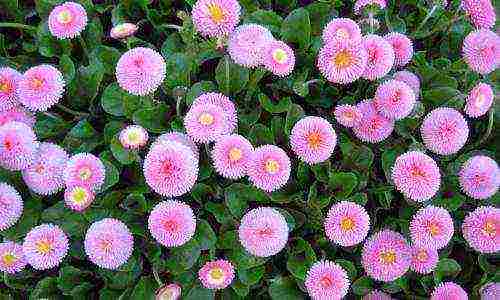
Daisy is a beautiful double flower that pleases with lush flowering for a long time. It can become a real decoration of your site.
Large, double, undersized, with different colors - any variety of flowers has its own unique look and beauty. Flowers can be grown not only on a personal plot, but also at home.
Daisies are propagated by seeds or by dividing bushes. Flowers grown from seeds are popular because they can be used to implement any ideas.
Growing from seeds at home begins 2 months before flowering, usually March-April. Germination temperature should be at least 21 ° C. After 2 weeks, the first shoots appear. After the leaves appear, the seedlings need to dive, and after a while, plant them in a permanent place.
For daisy flowers, cultivation must be carried out in compliance with certain rules.
They are not planted deeply, but sprinkled lightly with soil or river sand. They are planted in loose, well-fertilized, moist soil. The soil should not be wet or muddy. The soil must contain clay or sand. Better to plant them where there is good lighting.
At the time of planting, you need to use compost and humus. A good option is to add ammonium nitrate and potassium chloride during the growth process, with the help of which the flower will grow much faster.
In the second year, the flowers begin to bloom in May, continuing to delight with lush flowering all summer. Bloom again in September. The height of the plant is about 20 cm. In the first season, a leaf rosette grows, and next year the flower will bloom profusely. He tolerates the transplant well.
The first feeding is done immediately after the soil thaws. In early June, it is good to feed the flowers with an easily soluble fertilizer - nitroammophos. It is desirable that the fertilizer used contains phosphorus, which will improve the growth of the plant in the first season.
You can feed with a solution of agriculture and nitrophoska. These preparations are diluted in 10 liters of water, and then at least 1 liter is poured under each plant.
Water the daisies in moderation but regularly. On hot days, watering needs to be increased, but usually it is carried out about 3-4 times a week. From a lack of moisture, the flowers can become smaller and turn yellow.
Conveniently, daisies require almost no protection from disease. If the plant has damage, then it is simply removed along with the earth. In rare cases, powdery mildew, caterpillars or slugs may appear.
You can treat the flowers with a Topaz solution or other similar remedy. It is necessary to remove wilted inflorescences in time so that the plant does not consume nutrients on dead areas.
For reproduction, you can divide the flower bushes at the end of summer and plant them separately. This is a faster process than planting with seeds. The distance between the bushes should be about 20 cm. You can do this even during flowering. The plant is constantly renewing itself and gives young shoots.
Mulching the soil with sawdust, humus, peat will help preserve flowers better in winter. In autumn, it is advisable to cover the daisy with spruce branches, straw or leaves.
The plant goes well with many flowers. It can be used as a carpet plant or used to frame a pond with tulips, forget-me-nots or ferns.Daisies are well suited for decorating flower beds, borders, lawns.
Unpretentiousness, beauty and long flowering - these qualities of daisies are appreciated by many growers. Well-groomed plants will delight you with brightness, beauty and create a special festive mood.
Perennial daisy (bellis perennis) belongs to the Asteraceae family of the genus Astrovykh. The homeland of the plant is considered to be Southern and Central Europe. But because of its attractive appearance and unpretentiousness, it has spread throughout the world. Africa, North America, Australia, Europe - this flower culture is cultivated everywhere.
And the wild-growing flower form - the annual daisy (bellis annua), which is affectionately called the "pearl", can be found in the wild. She prefers to grow in forest glades, along the roadsides. The flower is small with small white or pinkish flowers.
Daisy is a perennial or perennial crop, grown as a two-year-old, with a compact rosette of elongated oval leaves. Bush height 15-30 cm. Shoots end with inflorescences 4-8 cm in diameter, white, pale pink or dark red color. In structure, flowers can be ligate and tubular in the form of daisies, buttons, buboes. The flower is used in landscape design for group plantings and as a greenhouse or balcony plant.
Planting daisies outdoors
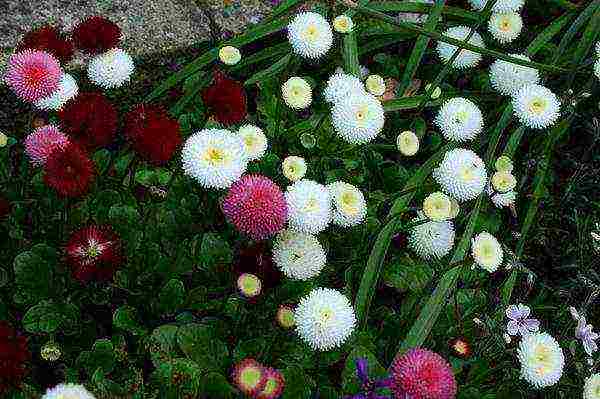
Daisies planting seeds Daisies in the garden photo
Since the daisy is a two-year-old plant, if it is grown with the help of seeds or cuttings, you can wait for a lush flowering only in the second year. For flowering this year, gardeners use methods: seedling or division.
It is more correct to grow daisies as a two-year crop. But growing a flower by dividing a bush rejuvenates the plant, while maintaining varietal characteristics and decorativeness. So, once again we list the methods of plant propagation: using seedlings, cuttings, dividing and sowing seeds in open ground. And now more about each method.
Growing daisies from seeds When to plant seedlings
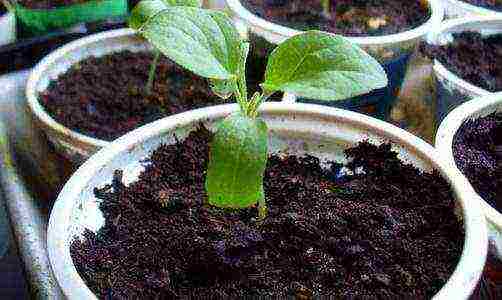
Daisies growing from seeds photo seedlings
When to sow daisies for seedlings? If you want the flower to bloom early, you need to sow the seeds in February-March. It is best to plant the seeds in separate containers. Pots made of paper, plastic or peat are suitable. In this case, if one or two plants have sprung up in the pot, they can not be dived. If a large container is used for planting seeds, the grown plants dive.
Seedlings grow well and do not get sick if the soil does not dry out and daylight hours lasts up to 14 hours. That is, it is necessary to provide illumination of the "young". Two weeks after the emergence of sprouts, the temperature at the location of the plants is reduced to + 15ºC. And the middle or end of May (7 days before planting seedlings in the ground) is the time for hardening the plant.
- Sow in a common container on top of moistened soil as rarely as possible, lightly sprinkle it with sand or earth on top. Remember to make drainage holes in the bottom to keep the plants from getting sick.
- The container is covered with a transparent lid or plastic bag to create a greenhouse effect, ventilated daily.
- After the shoots appear, the shelter is removed.
- Continue grooming with moderate watering, provide good lighting.
- Seedlings are planted when a pair of real leaves appear in separate cups.
- They begin to harden a week before planting, leaving the seedlings on the street first for a short time, then more, until a full day in the last days.
Daisies can be planted in April-May, when there will be no night frosts.
How to sow daisies for seedlings, the video will tell:
Daisy propagation by cuttings
Daisies from cuttings will bloom only next year. Reproduction in this way is carried out in the middle, end of May.A young shoot with an axillary bud is separated from the maternal specimen with a sharp knife.
Shoots treated with Kornevin are planted in the ground to a depth of 1 cm. The planting site is a cold greenhouse. After half a month, young plants take root. But they can be planted in a permanent place of growth only at the beginning of autumn, when a cool temperature is established.
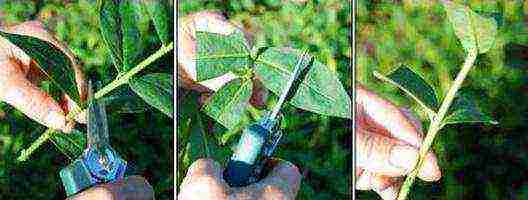
Cutting daisies photo
You can plant the cuttings on the windowsill, in separate cups, and just monitor the moisture content of the substrate. It is best to plant in special soil for flowering, so that the soil is nutritious and breathable. Rooted plants are planted in early September in a permanent place, not forgetting to cover for the winter.
Reproduction of daisies by dividing the bush
This procedure is carried out in early spring or after flowering. For division, take healthy two-, three-year-old bushes. They are carefully dug out, trying not to damage the root system, and divided into 5-10 parts. Of course, every part must be rooted. Flowers and buds on new plants are removed, the roots are shortened to 10 cm.
Dividing a daisy flower bush makes it possible to rejuvenate plants, get new specimens, while maintaining varietal characteristics and decorativeness.
Sowing daisy seeds in open ground
How to sow daisies outdoors
Blooming daisies when sowing in a garden will come only next year. In open ground, seeds are sown when the soil ripens, at the end of March - April and until the end of summer... The method of sowing on the soil surface is used, i.e. the seeds are not buried in the soil, but scattered over the site and mulched from above with humus or prepared sifted earth. If the seeds are not immediately covered with earth, but first covered with a dark film and left for two days, their germination will accelerate.
The soil with the planted seeds is regularly and carefully watered, not allowing it to dry out. To create greenhouse conditions, you can cover the area with seeds with agrofibre. It will protect delicate seedlings from the bright spring sun and protect from nighttime temperature drops.
The sprouts appear in two weeks, and after another two weeks they dive into the garden or nursery. Daisies are planted tightly. The distance between them should be no more than 5 cm.
Grown plants are planted in a prepared area at the end of summer. And already next year, in early spring, they will delight us with abundant flowering.
Young plants that have emerged as a result of the so-called "self-seeding" are weeded out, removing weak and damaged ones. Plants grown in this way lose decorativeness and characteristics of the variety: color brightness, flower size, terry.
Planting daisy seedlings in open ground
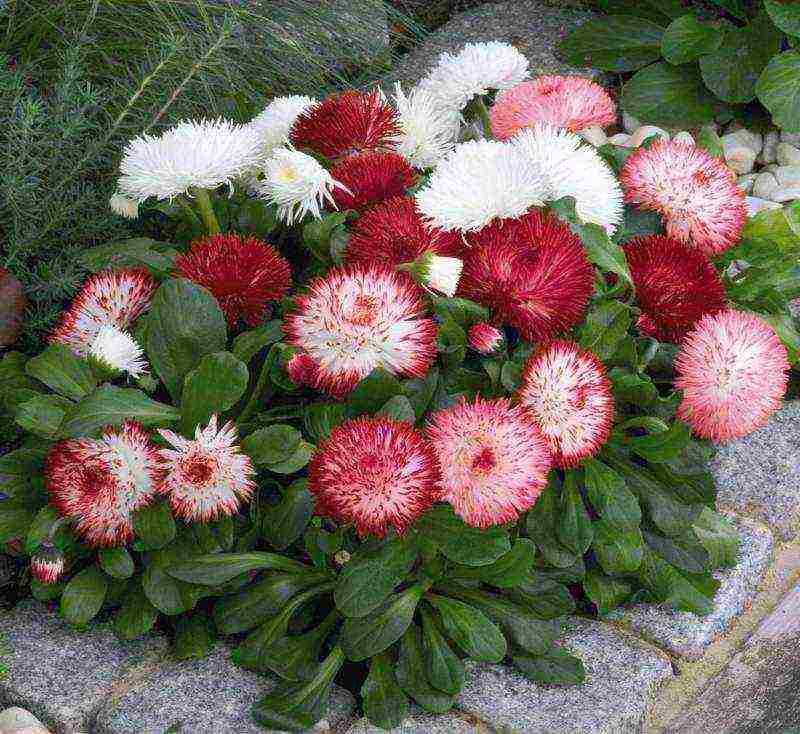
Daisies perennial photos planting and care
In order for the flower to grow and not get sick, it is necessary to choose the right site and composition of the soil. The daisy loves bright lighting. Also, a section in the near-trunk circle of a tree, in partial shade, is suitable for her. Only the Cape daisy prefers bright sunlight, and in the shade it fades and loses color.
The plant prefers a light, drained, moisture-permeable soil. A loam with neutral acidity is best. If the soil on the site is sandy, then it is mixed with manure, leafy soil, humus, ash, peat.
Perennial daisies grown from seeds are planted in a prepared area 30 days after diving. The transplant is performed with a lump of earth to preserve the root system of the seedling. The distance between young daisy bushes is up to 20 cm.
It is not worth planting less often, since the effect of group planting will be disrupted. Also, flowers planted strictly along the line will not look interesting. After planting, water the plants with plenty of water.
Interesting fact. The perennial daisy loves transplants. They activate the growth and development of the plant even at the stage of flowering and budding.
Outdoor Daisy Care
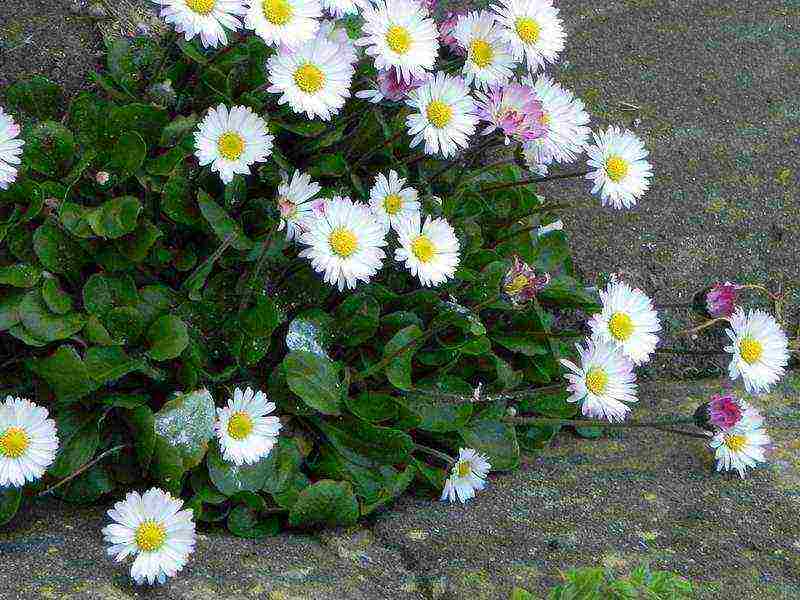
Daisy growing from seeds when to plant a photo
Daisies planted densely do not need to be weeded. But regular watering must be mandatory: in hot weather - every day, the rest of the time up to three times a week. Excess moisture is detrimental to the flower. His roots can rot. To reduce the frequency and volume of watering, mulching of the soil between plants is used.
In spring, during the snowmelt period and after heavy rains, the soil is loosened in order to improve aeration.
Interesting fact. Perennial daisy drowns out almost all weeds during growth. This property of the plant is highly regarded by gardeners. Indeed, in the soil after daisies there are almost no weed seeds.
The flower responds well to feeding. Several of them are held during the season:
- in spring 1 time (complex flower fertilizer);
- 3-4 times in summer with an interval of at least 10 days (potassium chloride, "Amofoska").
To add decorativeness to the flower and lengthen the flowering time, faded inflorescences are cut from it.
Diseases and pests of daisies
Daisy is unpretentious and many diseases are not terrible for her. But it is susceptible to diseases such as: gray rot, rust, powdery mildew. The plant can also be damaged by rodents and insects.
1. Gray rot
The cause of the disease is damp cold weather.
The appearance of the bush is watery leaves with a gray bloom.
Disinfection - removal of the infected part of the plant.
Prevention - moisture reduction.
Preparations for processing - "Skor", "Pure color".
2. Rust
The cause of the disease is fungal infection.
The appearance of the bush is leaves with rusty-red or brown spots.
Disinfection - removal of the infected part of the plant.
Prevention - destruction of plant residues, loosening.
Preparations for processing - 1% solution of Bordeaux liquid.
3. Powdery mildew
The cause of the disease is soil oversaturation with nitrogen fertilizers, lack of moisture.
The appearance of the bush - the leaves darken, a white bloom appears above and below.
Disinfection - removing an infected part of a plant or destroying an entire bush.
Prevention - destruction of plant residues, thinning.
Preparations for processing - "Chistotsvet", "Fitosporin", "Trichodermin".
4. Brown spot
The cause of the disease is the defeat of the plant by bacteria.
The appearance of the bush - the leaves are covered with light spots with a border.
Disinfection - removing an infected part of a plant or destroying an entire bush.
Prevention - destruction of plant residues, loosening.
Preparations for processing plants - "Kuprotoks", "Hom"
Preparations for soil cultivation - ferrous sulfate solution, 3% Bordeaux liquid solution.
To protect flowers from animals - rodents: mice, shrews, moles - a poisoned bait is left on the site. Be careful not to poison her pets.
Insects That Can Harm Planting Daisies (spider mites and thrips) are destroyed by repeated spraying of the plant and soil. For spraying use solutions of laundry soap, celandine, "Aktara", "Iskra".
How to collect daisy seeds
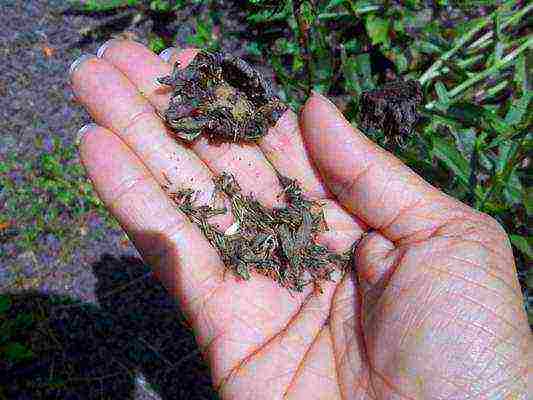
How to collect daisy seeds photo
Since with proper storage, the germination of daisy seeds lasts up to three years, it makes sense to collect and save seed material. One condition is that the seeds are harvested from non-hybrid plant varieties.
The rules for collecting seeds are as follows:
- seeds are collected only from faded inflorescences;
- flowers, laid out in 1 layer, are dried on a paper bed;
- dried until the seeds fall out of the inflorescences easily;
- store seeds in paper or cloth bags, which indicate the year of collection, the name and variety of the flower.
Preparing daisies for winter
This is an important step that should not be neglected. Failure to comply with the wintering conditions can lead to partial decay of the roots or to the complete death of the plant.
In order for the plant to overwinter well, remove dried leaves and flowers around the bush, cover the roots with earth that are on the surface of the soil.
Then cover the ground around the bush. Suitable as mulch: humus, rotted sawdust, needles, peat. The layer of mulch should be at least 5-10 cm. It is undesirable to use fallen leaves as mulch and covering material.
They can serve as breeding grounds for fungal spores or shelter for insect pests. At the same time, fallen leaves, placed in a compost heap, are an excellent component for compost.
Plants winter best under a snowy blanket, but if your winters are not snowy, you should cover the daisy bushes with spruce branches or other covering material.
Daisies in landscape design What to combine with
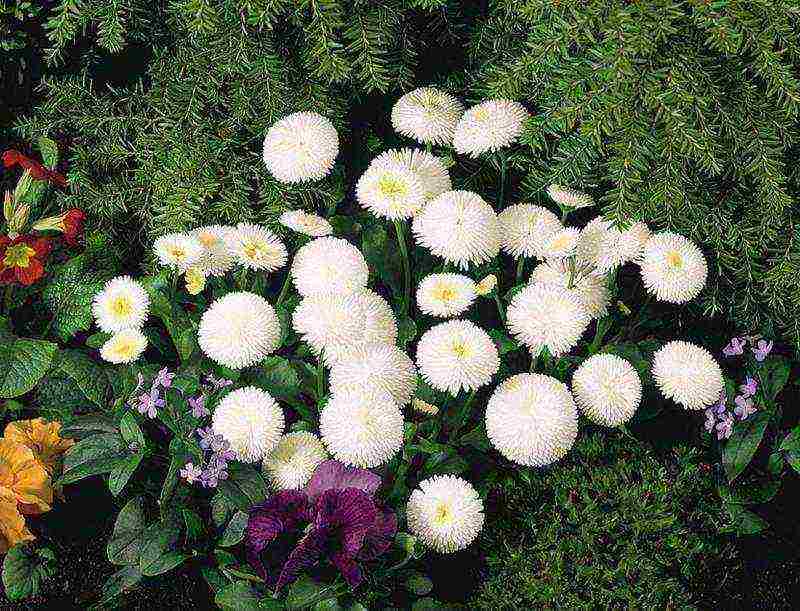
Daisies planting and caring for a photo of a mixborder
Perennial daisy is a culture demanded by gardeners, designers and florists.
This is facilitated by such qualities of a perennial as:
- unpretentiousness;
- long flowering period;
- a variety of flower shapes and a wide range of colors;
- good compatibility with other plants.
In single planting, daisies are not very interesting, so they are best used as a companion crop for taller plants, for example, spring flowering bulbs: daffodil tulips. Or in combination with primroses, lilies of the valley, hyacinths.
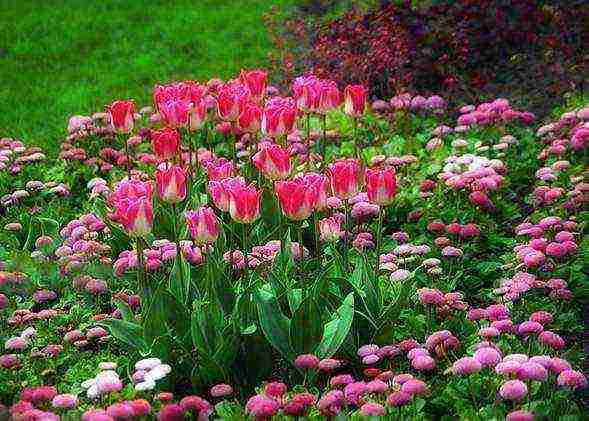
Daisies and tulips photo flower beds
There are a number of garden compositions that will play well without daisies.
Daisies are planted:
- Near natural ponds and streams, artificial reservoirs, thanks to the love of moist soil.
- On lawns that are not mowed (urban, Mauritanian, meadow) as a ground cover crop.
- In group plantings (up to 10 bushes at a time). Here you can show your imagination and use both plants of the same color and variety, and completely different ones.
- Daisies with small flowers are suitable for curbs, on alpine slides.
Here you should pay attention to the regularity of watering. - Cape daisies, which reach a meter in height, are used for the "back wall" of ferns, host, brunger, and bodans.
Perennial daisies are also used in group plantings on flower beds, ridges, balconies, in separate containers, as well as for cutting and forcing.

Daisies in garden design photo
Florists love this versatile culture. Low compact bushes of the plant look beautiful in ceramic flowerpots, pots and containers. Such flower arrangements can decorate your favorite corner of the garden, greenhouse, terrace, balcony, patio, garden gazebo.
A small round bouquet of white or pale pink daisies can even be used as a wedding bouquet. A pot with bright buttons - flowers against the background of green leaves will be a nice gift.
Types and varieties of perennial daisies with descriptions and photos
There are about a hundred species of perennial daisies. They differ in the following ways:
- by the height of the culture. Height varies from 2 to 30 cm;
- by the structure of the flower. It can be reed or tubular;
- according to the shape of the flower. It comes in the form of a ball, chamomile, pompom, rose;
- by the type of color of the petals. Distinguish between monochromatic, with varying degrees of color on the upper and lower sides, with stripes, with specks. The color varies from snow-white to bright red;
- by the type of terry. There are plants with simple, double and semi-double flowers;
- by the size of the inflorescence. Flowers are small from 1.5 cm in diameter, medium from 4 cm in diameter and large from 6 cm.
In addition, varietal daisies differ in the time of the beginning of flowering: early and late flowering.
Among the abundance of varieties and types of flower culture, the most popular among gardeners can still be distinguished. So, mainly terry and semi-double varieties and perennial hybrids are cultivated.
The most beautiful varieties of daisies with names and photos:
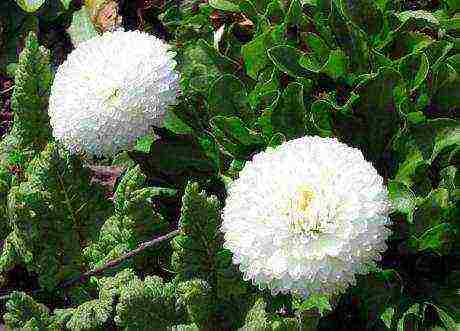
Daisies variety White ball photo and description
"White ball" - plant height 15 cm, pure white double flowers.
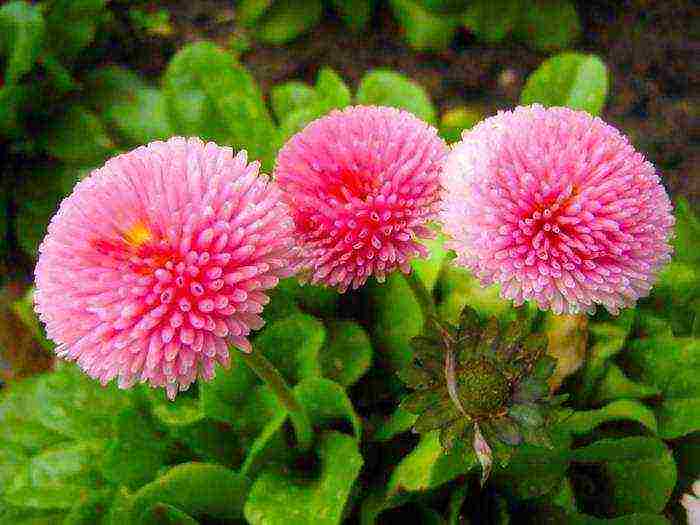
Daisies variety Pink ball photo and description
"Pink ball" - plant height 15-20 cm, double carmine flowers.
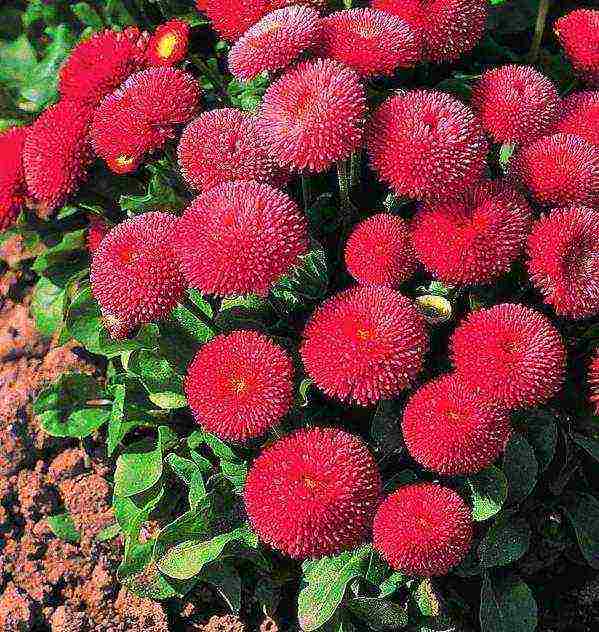
Daisies variety Red carpet photo Growing and care
"Red carpet" - plant height up to 20 cm, dark red double flowers.
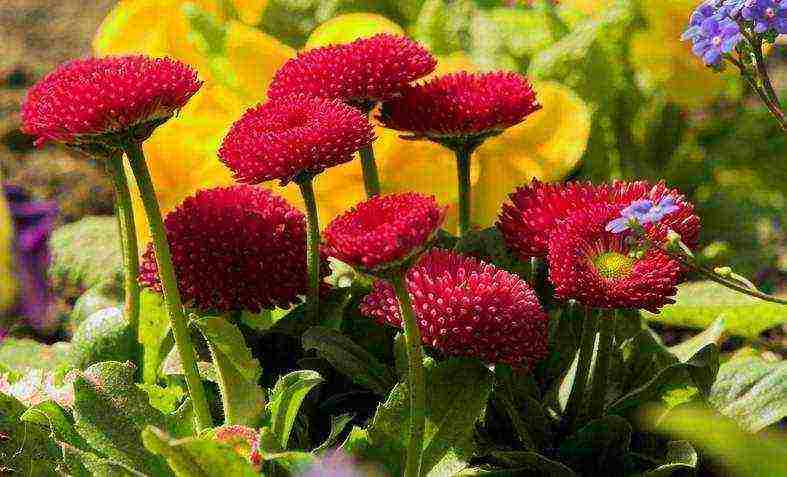
Daisy grade Etna photo in the garden
"Etna" - color of flower petals: orange center and dark purple edges.
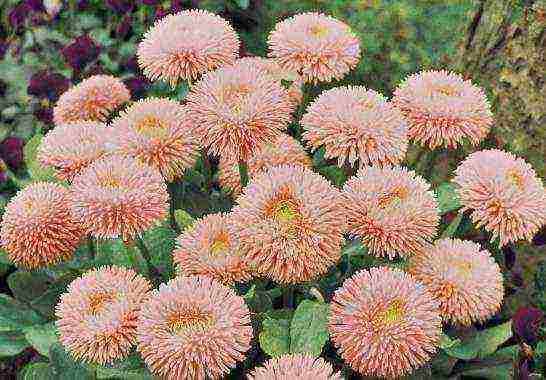
Robella daisies photo in the garden
"Robella" - color of flower petals: coral in combination with red.
Balcony varieties with abundant and long flowering are also in demand. Airlie Etna, Dresden Chyna, The Pearl are compact plants suitable for forcing in winter and early spring.
African daisy or Cape Osteospermum ecklonis
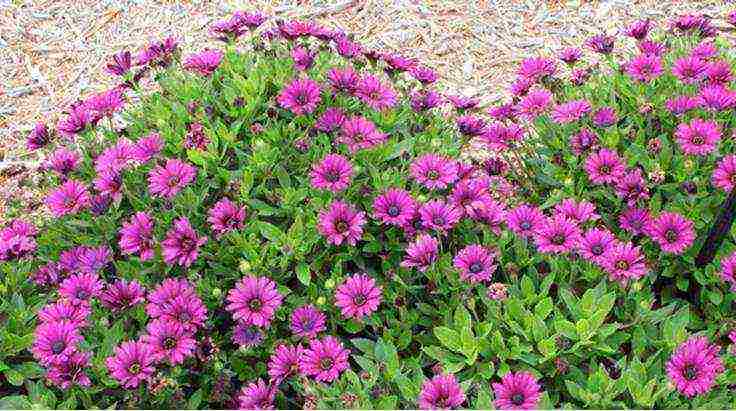
African daisy or Cape Osteospermum ecklonis photo in the garden
The so-called Cape daisies or African daisies (osteospermum) also belong to the Astrov family. These are evergreen perennial shrubs or semi-shrubs. They grow up to a meter in height and have flowers similar in appearance to daisies or daisies.

